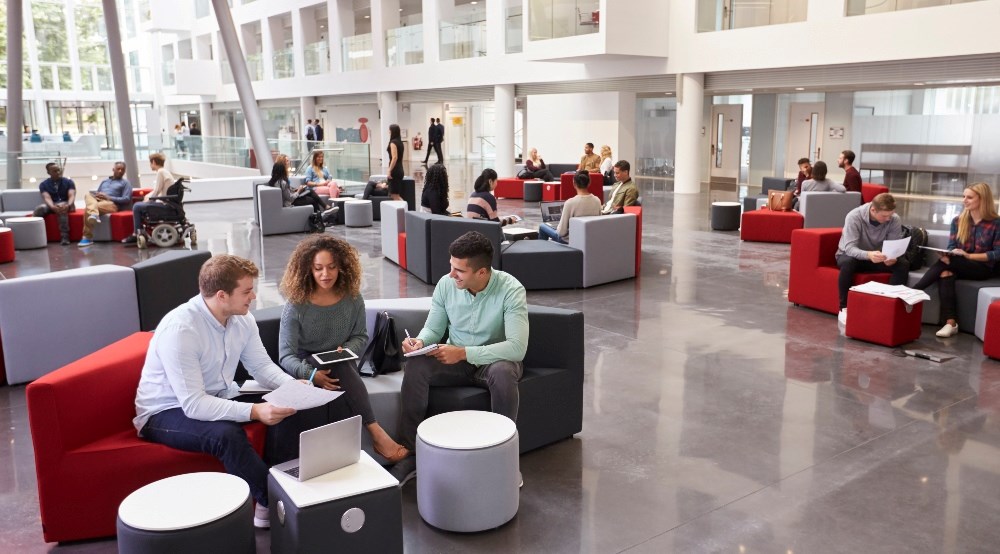
Let us help you with finding an office space
Our experts are here to help take the hard work out of finding your next office space.

Agile working might sound like a corporate buzzword, but it refers to a specific working methodology that has real relevance to modern employers. Very simply, agile working gives your team the tools, technology and space they need to work in a way that suits their particular objectives at the time.
While flexible working focuses on ‘where’ and ‘when’ people work, agile working is all about ‘how’ they work. So where does office design fit into the mix? Agile office space design is all about creating a variety of useful spaces where your employees can be comfortable, productive and able to do their best work.
Agile workspace design is well suited to businesses that are driven by clear objectives and adaptable processes, where everyone knows what they’re doing and can work autonomously. This is particularly the case in highly collaborative and sociable industries — creative agencies, software companies, product developers and corporate teams, for example, can benefit from the flexibility and autonomy that agile office design provides.
As the role of the office changes, flexible office space rental can be an effective way to introduce the agile methodology into your workplace and provide the variety and choice that many employees now crave.
There’s no single form or shape that an agile workspace needs to take. To be truly agile, you should create it with the specific needs of your team in mind. It should include a variety of shared spaces that workers can move between freely, along with quiet and private spaces that encourage and support solo activity.
In agile office space design, designated desks are few and far between. Teams might be assigned clusters, but staff are typically encouraged to work away from the desk and in one of the other settings that are well-suited to particular tasks. For example:
As the general workforce continues with hybrid working arrangements, an agile working environment can help employers reduce their costs by cutting down on any unused floor space in the event that more employees work from home on any given day.
For employees who are now used to remote or hybrid work, an agile workplace design gives them an attractive alternative to being tethered to their desks five days a week and working alone at their kitchen table. Instead, staff have access to a responsive, flexible space that’s available when they need it.

An agile working environment encourages employees to move around the office and takes them away from a fixed bank of desks. That creates pockets of teamwork and creativity, allowing ideas to be shared freely between teams and departments.
It’s often the case that agile workspace designs require less square footage than traditional layouts. That leads to reductions in your leasing costs and savings on utilities, maintenance and cleaning.
Designing an agile office space is all about creating spaces that facilitate different ways of working. While it invites freer collaboration and communication, it also provides quiet spaces away from the noise of traditional office layouts so your team can work without distractions when they need to.
Flexible working and having autonomy over their working day are now more important than salary for 59% of workers. Creating an agile working environment supports this by giving workers the freedom to approach tasks on their terms and choose where and how they work. That can boost employee satisfaction, helping you keep hold of your best talent.
When it comes to your agile workspace design, you should think about work as an activity, not a designated place. With that in mind, the perfect office space should accommodate the whole spectrum of different working styles and tasks your teams will be involved in. It should incorporate spaces for collaboration, inspiration and relaxation as well as concentration, private meetings and quiet reflection.
An important first step in designing your agile office space is discussing the plan with your team and asking for their input. They use the space every day, so they will likely have suggestions you may not have thought of and different design elements to consider, including the following:
Agile office spaces are generally geared towards collaborative use, with large, open plan areas typically being the backbone of this working methodology. Designed to increase collaboration and employee interaction, an open plan model should offer several seating options and minimise the use of private and enclosed areas. As a space-efficient design format, these open offices typically allow for more people per square foot than other types of designs.
A free address seating plan goes one step further than an open plan model, with employees free to sit anywhere they like on a first-come, first-served basis. As they’re completely untethered to a desk, staff can change their workstation on a daily or task basis. This approach removes the hierarchical feel of a traditional office plan and encourages employees of all ranks, departments and experiences to mix.
Open plan and free-address seating plans undoubtedly have their downsides but these can be mitigated by creating quiet zones. This ‘quiet’ part of your agile office is designed for privacy and concentration, allowing your employees to focus on important tasks.
These quiet zones can take the form of soundproof, self-isolating booths or simply be an area within your office where conversations and phones are not allowed.
Another important part of any agile workplace design is creating dedicated meeting spaces. While breakout spaces might be fine for informal meetings and teamworking, enclosed rooms and booths that accommodate multiple people and provide privacy are better suited to client meetings and formal presentations.
Meeting pods for four to six people come equipped with built-in screens for video conferencing, while huddle rooms (two to six people) and conference rooms (larger groups) provide a little more privacy.
Breakout spaces are the most informal part of an agile workspace. This is where your employees can get away from their screens, have laid-back meetings, grab something to eat and take a breather. These highly flexible areas often feature soft and comfortable furniture to create a home away from home. Sofas, armchairs, ottomans and lamps are all popular, as are table tennis tables or games machines that let employees get into a different headspace and have a little fun.

For some organisations, it might be possible to change the layout of their current working environment to create an agile office space. While that will require some upfront investment and potentially lead to disruption and downtime, it allows you to keep the same physical location, if that’s a priority.
For many others, the switch to an agile working environment brings with it the opportunity to downsize, reduce costs and adapt to a hybrid working model. In this case, flexible office spaces can help. You rent only the space needed and have the freedom to be flexible about how you use it.
Design-wise, most providers of managed offices, coworking spaces and serviced offices are moving with the times and offering agile working environments that suit modern working styles. Alternatively, you could choose to rent a managed office and customise the space with your own agile workspace design.
At Knight Frank, the hard work is done for you. Whether you need a coworking, flexible or private office space, just tell the team what you’re looking for and they’ll find your perfect agile office space. The team will get you booked in and accompany you to viewings, and even use expert market knowledge to help you negotiate the best lease.
Get your monthly dose of workplace insights, productivity hacks and business leadership ideas - delivered straight to your inbox.

Our experts are here to help take the hard work out of finding your next office space.